- Prelude
- Editorial
- ...Where ever I stumble, let painting lie before me....
- ...Colour guides in its own direction...
- Abstract Art: Popular Myths and History
- Abstract Rhetoric:
- Ram Kumar: A transition from figurative to abstract
- I walk the line
- Exploring a twilight zone
- Articulating the Abstract voice from Madhya Pradesh
- Perception of Abstract in forms
- Confronting Cultures: The Dialectic of Abstraction in Bengal Art
- K.C.S. Paniker and his Words and Symbols
- Dialectics of Abstract Art and Its Indigenous Identity
- Between Ambivalence and Criticism: Why Abstraction?
- Notations and Rhythm in Space: Sushen Ghosh
- Victorian Era: Eclectic Furniture
- Patek Philippe : an overview
- The “Theme Pandals” of Durga Pujo: An Unexplored Discourse
- Musings on Music
- Butterflies in the stomach… still
- Contemporary Art Market Report 2009-10
- Artist Index and Statistics
- Auction Reports
- Recent works of Pavan kumar D. - In the Journey of Learning things
- Narrating “with a pinch of salt” Paintings of K.P.Reji
- Reclaiming an artist of true calibre
- Musings from Chennai
- An Annual Homage..
- Art Events Kolkata: September-October 2010
- Mumbai Art Sighting
- Art Bengaluru
- Unveiling the next in line
- Preview
- In the News
- Sotheby’s : Important Watches Hong Kong
ART news & views
Auction Reports
Volume: 3 Issue No: 10 Month: 11 Year: 2010
Bonham's
Tipu's throne-head sweeps the stakes
October 7
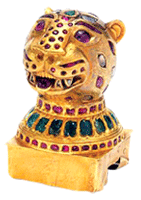 A gem-studded, solid gold tiger's head that once adorned Tipu Sultan's throne was sold at at Bonham's on October 7 for more than $700,000. The unidentified Canadian family -- described by Bonhams as having had "no idea" how much a mysterious collection of 200-year-old heirlooms might be worth -- was the highlight of the London-based auction house's sale of important Islamic and Indian art. Along with the elaborately crafted tiger's head -- studded with diamonds, rubies and emeralds, and which had been expected to sell for a maximum of about $480,000 -- the Canadian family also consigned a gem-encrusted sword from the same era and a spherical gold container once used to hold bezoar stones. The masses of hair and minerals found in the stomachs of goats and other grazing animals were coveted in historic times as protective talismans. The sword and bezoar-stone holder, each valued at about $25,000 ahead of the sale, sold for about $31,000 and $62,000, respectively. That brought the Canadian family's total take from the auction to just under $800,000, minus a buyer's premium of about 15 per cent. The three objects were originally acquired as spoils of war by British Lt.-Gen. Sir Thomas Bowser, a leader in the British victory over Tipu and his army on May 4, 1799.
A gem-studded, solid gold tiger's head that once adorned Tipu Sultan's throne was sold at at Bonham's on October 7 for more than $700,000. The unidentified Canadian family -- described by Bonhams as having had "no idea" how much a mysterious collection of 200-year-old heirlooms might be worth -- was the highlight of the London-based auction house's sale of important Islamic and Indian art. Along with the elaborately crafted tiger's head -- studded with diamonds, rubies and emeralds, and which had been expected to sell for a maximum of about $480,000 -- the Canadian family also consigned a gem-encrusted sword from the same era and a spherical gold container once used to hold bezoar stones. The masses of hair and minerals found in the stomachs of goats and other grazing animals were coveted in historic times as protective talismans. The sword and bezoar-stone holder, each valued at about $25,000 ahead of the sale, sold for about $31,000 and $62,000, respectively. That brought the Canadian family's total take from the auction to just under $800,000, minus a buyer's premium of about 15 per cent. The three objects were originally acquired as spoils of war by British Lt.-Gen. Sir Thomas Bowser, a leader in the British victory over Tipu and his army on May 4, 1799.
Philips de Pury
World records for David Hockney, Aaron Young, Sterling Young and Dana Schutz
October 13
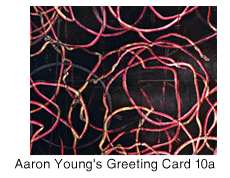 Phillips de Pury & Company's Contemporary Art Evening sale totaled $10,303,753 (including premium) selling 86% by value and 69% by lot. There was particularity strong competition for the works by top British artists including world records broken for Aaron Young's Greeting Card 10a, which sold for $190,363, Sterling Ruby'sSP58, which sold for $303,403, David Hockney's (work on paper), Autumn Pool (Paper Pool 29) which sold for $1,329,250, Dana Schutz's, Frank in the Desert, 2002 which sold for $284,563, Lothar Hempel's,Casanova, 2007 which sold for $23,550 and Andy Hope 1930, 4419 (AH/M), which sold for £20,000/$31,400.
Phillips de Pury & Company's Contemporary Art Evening sale totaled $10,303,753 (including premium) selling 86% by value and 69% by lot. There was particularity strong competition for the works by top British artists including world records broken for Aaron Young's Greeting Card 10a, which sold for $190,363, Sterling Ruby'sSP58, which sold for $303,403, David Hockney's (work on paper), Autumn Pool (Paper Pool 29) which sold for $1,329,250, Dana Schutz's, Frank in the Desert, 2002 which sold for $284,563, Lothar Hempel's,Casanova, 2007 which sold for $23,550 and Andy Hope 1930, 4419 (AH/M), which sold for £20,000/$31,400.
Christies'
Islamic art realizes $25.1 million
October 16
 The auctions of Islamic and Indian Art at Christie's in London realised a combined total of $25.1 million/ €18.2 million and were 82% sold by value. William Robinson, Director and Head of Islamic Art, Christie's London said after the auction, “The results of our auctions this week at both King Street and South Kensington illustrate a continuing hunger for beautiful works of quality and rarity across our entire market. The notable resurgence in demand for rugs and carpets demonstrates an increased appreciation of this field, undoubtedly spurred - in part - by the extraordinary world auction record set in April this year when the Kirman carpet realised £6.2 million. The depth and breadth of participation from new bidders in Asia and the Middle East was apparent throughout the week, with works of art and carpets at every price level attracting considerable interest and competitive bidding.”
The auctions of Islamic and Indian Art at Christie's in London realised a combined total of $25.1 million/ €18.2 million and were 82% sold by value. William Robinson, Director and Head of Islamic Art, Christie's London said after the auction, “The results of our auctions this week at both King Street and South Kensington illustrate a continuing hunger for beautiful works of quality and rarity across our entire market. The notable resurgence in demand for rugs and carpets demonstrates an increased appreciation of this field, undoubtedly spurred - in part - by the extraordinary world auction record set in April this year when the Kirman carpet realised £6.2 million. The depth and breadth of participation from new bidders in Asia and the Middle East was apparent throughout the week, with works of art and carpets at every price level attracting considerable interest and competitive bidding.”
Sotheby's
First ever Islamic art sale realizes topples estimates
October 5
Sotheby's first-ever Evening Sale of Islamic Art, A Princely Collection: Treasures from the Islamic World, realised the remarkable total of £7,070,550, against a pre-sale estimate of £3.4-4.8 million, and established strong sell-through rates by lot and value of 96% and 88% respectively. 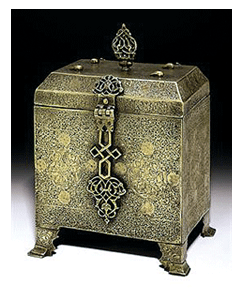 Of the lots sold, 75% achieved sums in excess of their pre-sale high estimates.
Of the lots sold, 75% achieved sums in excess of their pre-sale high estimates.
Headlining this evening's auction was the sale of a rare and important Abbasid luster pottery bowl, dating to the second-half of the 9th century, which was the subject of intense competition. The bowl, which displays a sparse and striking stylised foliate pattern reminiscent of the tilework in the Great Mosque of Qairawan in Tunisia realised the extraordinary sum of £713,250, and sold to an anonymous telephone bidder for almost four times the low estimate (lot 60, est.: £200,000-300,000).
Commenting on the results, Edward Gibbs, Senior Director and Head of Sotheby's Middle East Department, said: “Tonight's auction of Islamic Art the first Evening Sale in this collecting category ever to be staged represents a landmark moment for the field. These extraordinary results are confirmation of the discerning eye of the collector who assembled this collection of rare and high quality works of art, and also reflect the strength of this market and the ever-growing demand for desirable artefacts relating to the Islamic world.”
Six New Artist's Records Achieved
October 20
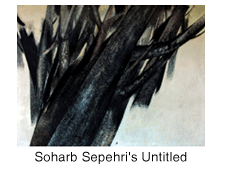 Sotheby's third dedicated auction of Contemporary Art: Arab and Iranian made a strong total of £3,189,250 at the top end of the pre-sale estimate of £2,293,5003,242,500. Competitive bidding, both in the room and on the phones, saw high prices achieved for both Modern and Contemporary works, including those from a collection of four paintings by leading Egyptian Modern artist, Mahmoud Said, which totalled £377,000 far above the estimate of £225,000- 315,000. The cover lot of the sale, Untitled (From the Tree Trunk Series) by Iranian artist, Sohrab Sepehri the largest and most significant work by the artist ever to come to auction fetched the highest price of the day, selling for £409,250 more than double the pre-sale low estimate of £200,000 and setting a new auction record for the artist.
Sotheby's third dedicated auction of Contemporary Art: Arab and Iranian made a strong total of £3,189,250 at the top end of the pre-sale estimate of £2,293,5003,242,500. Competitive bidding, both in the room and on the phones, saw high prices achieved for both Modern and Contemporary works, including those from a collection of four paintings by leading Egyptian Modern artist, Mahmoud Said, which totalled £377,000 far above the estimate of £225,000- 315,000. The cover lot of the sale, Untitled (From the Tree Trunk Series) by Iranian artist, Sohrab Sepehri the largest and most significant work by the artist ever to come to auction fetched the highest price of the day, selling for £409,250 more than double the pre-sale low estimate of £200,000 and setting a new auction record for the artist.
Important sale of clocks and watches
October 27
 Sotheby's New York sale of Important Watches & Clocks was a well-rounded auction that offered notable wristwatches and pocket watches, important pieces made for the Chinese Market, and unique collections that featured modern watches, ladies' pendant watches, and enamel form watches. The sale was estimated to at $3.4/4.9 million. The October auction in New York is highlighted by Property of a Trust, including An Important Ormolu, Silver Mounted and Colored Glass Center Seconds, Four Tune Musical Automaton Table Clock, with Quarter Striking, made for the Chinese Market, late-18th century, formerly in the Collection of Gustave Loup, Geneva, made by Francis Perigal of the Royal Exchange, London (est. $500/800,000). The design of this magnificent clock combines the creativity, opulence and novelty that characterize many of the finest clocks destined for use by the Chinese emperors of the 18th century.
Sotheby's New York sale of Important Watches & Clocks was a well-rounded auction that offered notable wristwatches and pocket watches, important pieces made for the Chinese Market, and unique collections that featured modern watches, ladies' pendant watches, and enamel form watches. The sale was estimated to at $3.4/4.9 million. The October auction in New York is highlighted by Property of a Trust, including An Important Ormolu, Silver Mounted and Colored Glass Center Seconds, Four Tune Musical Automaton Table Clock, with Quarter Striking, made for the Chinese Market, late-18th century, formerly in the Collection of Gustave Loup, Geneva, made by Francis Perigal of the Royal Exchange, London (est. $500/800,000). The design of this magnificent clock combines the creativity, opulence and novelty that characterize many of the finest clocks destined for use by the Chinese emperors of the 18th century.
SOTHEBY'S
The French connection
November 9
The Important Furniture, Sculptures and Works of Art sale in Paris on 9th November will feature a stunning set of precious clocks formerly in the renowned Mennesson Collection. Organised in association with SVV Chayette & Cheval, the collection shows the dis-cernment of Marcel Mennesson (1884-1976). The exceptional nature of this collection is illustrated by Antide Janvier (1751-1835). 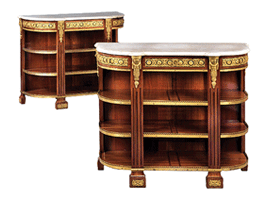 They range across his entire career from his earliest years as a young prodigy in the 1770s - a highly important armillary planetarium timepiece by Antide Janvier, 1774 and 1825 - through to the work of his prime a presentation, fifteen-day, mahog-any, double dial and triple movement grande sonnerie pedestal regulator with calendar and lunar indications - to his later years - a month-going calendrical mahogany table regulator from 1820. All three clocks are crucial documents of Janvier's life-long endeavour to realise fully the horolo-gist's dream across many centuries of representing the motion of the heavens in the simplest possible mechanical way. In addition this sale includes a fine selection of furniture and works of art such as a fine Consulat mahogany and ebony bureaud'architecte, a rare pair of early Louis XV giltwood armchairs, miscellaneous giltbronze ob-jects such as a pair of Louis XV wall-lights chased with sunflowers attributed to Caffieri and a Louis XV cartel clock with lacquered Chinese figures. The highlights of the Sculptures and Work of Arts section feature an important terracotta sculpture of the Sleeping Eros by Joseph Chinard (Lyon, 1756-1813), combining an exceptional modelling beauty with a prestigious origin from the collection of the count Giovanni Battista Sommariva (1760-1826), to which it be-longed until 1839. Furthermore, the Sleeping Eros has been presented at the exhibition dedicated to the artist in 1909 at the Pavillon de Marsan.
They range across his entire career from his earliest years as a young prodigy in the 1770s - a highly important armillary planetarium timepiece by Antide Janvier, 1774 and 1825 - through to the work of his prime a presentation, fifteen-day, mahog-any, double dial and triple movement grande sonnerie pedestal regulator with calendar and lunar indications - to his later years - a month-going calendrical mahogany table regulator from 1820. All three clocks are crucial documents of Janvier's life-long endeavour to realise fully the horolo-gist's dream across many centuries of representing the motion of the heavens in the simplest possible mechanical way. In addition this sale includes a fine selection of furniture and works of art such as a fine Consulat mahogany and ebony bureaud'architecte, a rare pair of early Louis XV giltwood armchairs, miscellaneous giltbronze ob-jects such as a pair of Louis XV wall-lights chased with sunflowers attributed to Caffieri and a Louis XV cartel clock with lacquered Chinese figures. The highlights of the Sculptures and Work of Arts section feature an important terracotta sculpture of the Sleeping Eros by Joseph Chinard (Lyon, 1756-1813), combining an exceptional modelling beauty with a prestigious origin from the collection of the count Giovanni Battista Sommariva (1760-1826), to which it be-longed until 1839. Furthermore, the Sleeping Eros has been presented at the exhibition dedicated to the artist in 1909 at the Pavillon de Marsan.
Warhol's coke and other symbolons in New York
November 9
 This season's Contemporary Art sale offers a selection of extraordinary paintings and sculptures. The centerpieces of the sale include Mark Rothko's powerful and luminous Untitled of 1955 which has not been on the market for 40 years, Andy Warhol's iconic master-piece of 1962 Coca- Cola-- the Large Coca-Cola which is a landmark in the artist's creation of his Pop art style and choice of commercial imagery loaded with provocative symbolism about America, and Roy Lichtenstein's Ice Cream Soda from 1962, a classic example of the single-object still lives of the artists early Pop period which has been in the same distinguished collection since it was painted. Other highlights include Willem de Kooning's Montauk III from 1969, Gerhard Richter's Matrosen (Sailors) an important 1966 photo-painting being sold by the Weser-burg Museum für moderne Kunst in Bremen, and Figure in Movement by Francis Bacon, a significant 1985 painting demonstrating the artist's genius in depicting the human form that was given by the artist to his physician and has been included in many prominent exhibitions of the artist's work.
This season's Contemporary Art sale offers a selection of extraordinary paintings and sculptures. The centerpieces of the sale include Mark Rothko's powerful and luminous Untitled of 1955 which has not been on the market for 40 years, Andy Warhol's iconic master-piece of 1962 Coca- Cola-- the Large Coca-Cola which is a landmark in the artist's creation of his Pop art style and choice of commercial imagery loaded with provocative symbolism about America, and Roy Lichtenstein's Ice Cream Soda from 1962, a classic example of the single-object still lives of the artists early Pop period which has been in the same distinguished collection since it was painted. Other highlights include Willem de Kooning's Montauk III from 1969, Gerhard Richter's Matrosen (Sailors) an important 1966 photo-painting being sold by the Weser-burg Museum für moderne Kunst in Bremen, and Figure in Movement by Francis Bacon, a significant 1985 painting demonstrating the artist's genius in depicting the human form that was given by the artist to his physician and has been included in many prominent exhibitions of the artist's work.
Rare watches in Geneva
November 14
This autumn sale of Important Watches in Geneva is bringing together an impressive range of timepieces charting the evolution of watch making from 1620 to the present day. The auction will be spearheaded by an exceptional selection of very rare enamel timepieces, made for the Chinese and Turkish markets during the 18th and 19th centuries. Highlighting the out-standing group of historic pieces are unique time-keepers and automata made for the Chinese market. Watchmakers, goldsmiths, painters on enamel and engravers worked together to create unique pieces for the Chinese market, as shown in the highlight of the sale - a rare gold, enamel, jewel and pearl-set automaton caterpillar, probably made by Henri Maillardet in 1800. The sale will also include fine examples of timepieces made for the Turkish market in the end of the 18th century and the beginning of the 19th century. The subject of increasing interest among worldwide collectors for antique pocket watches, feature strongly in the sale, covering four centuries of history from the 17th century to the 20th century. Completing this historic panorama of pocket watches is a very fine and rare yellow gold and hardstone-set open-faced watch by Breguet, which was sold on 20 March 1839 to Madame la Générale Adadouroff. The sale will also include a comprehensive selection of vintage wristwatches by the greatest watchmakers and promises to appeal to international watch collectors and connoisseurs. Chinese Ceramics and Works of Art: 9 November, Christie's King Street.
Highlighting the out-standing group of historic pieces are unique time-keepers and automata made for the Chinese market. Watchmakers, goldsmiths, painters on enamel and engravers worked together to create unique pieces for the Chinese market, as shown in the highlight of the sale - a rare gold, enamel, jewel and pearl-set automaton caterpillar, probably made by Henri Maillardet in 1800. The sale will also include fine examples of timepieces made for the Turkish market in the end of the 18th century and the beginning of the 19th century. The subject of increasing interest among worldwide collectors for antique pocket watches, feature strongly in the sale, covering four centuries of history from the 17th century to the 20th century. Completing this historic panorama of pocket watches is a very fine and rare yellow gold and hardstone-set open-faced watch by Breguet, which was sold on 20 March 1839 to Madame la Générale Adadouroff. The sale will also include a comprehensive selection of vintage wristwatches by the greatest watchmakers and promises to appeal to international watch collectors and connoisseurs. Chinese Ceramics and Works of Art: 9 November, Christie's King Street.
CHRISTIE' S
Asian Art Week London commences
November 9
The Asian Art week starts with a remarkable array of porcelains, metal work, furniture, and organic materials such as jade, ivory and rhinoceros horn, offered in the Fine Chinese Ceramics and Works of Art sale. Featuring over 350 lots, dating from the Shang Dynasty (1600 - 1100 BC) to the Republic Period (1912-49), estimates range from £2,000 up to £1.2 million. The sale is expected to realise in excess of £8million. The star lot of the whole sale is ceramic: an important and very rare small guanyao baluster vase, Hu southern Song dynasty (1127-1279), 13th century which is offered from the Ronald Longsdorf Collection. This exquisitely delicate rich greyish-blue glazed vase has extensive, highly attractive crackle and is of beautiful proportions, measuring just 5.1/8 in. (13 cm.) tall. The bulbous lower body is supported on a tall slightly splayed foot, 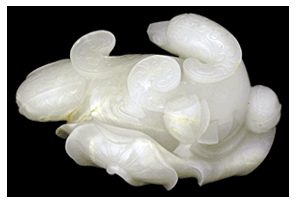 with a tapering neck which ends with a flaring dished rim. Important porcelains include a magnificent famille rose armorial 'goose' tureen and cover, Qianlong, (1765-75) with the coat-of-arms for the Spanish family of Ochoa de Olza in a cartouche at its breast (estimate: £200,000-300,000), which is offered from the property of a private European collector. The service was made for Domingo Esteban de Olza y Domezain (1723-1816), Olza was a resident of Cádiz and was registered as a merchant in 1755, and he was the first delegate of The Royal Company of the Philippines, from when it was founded in 1785 until 1797. This is a rare surviving example of an armorial tureen of this shape, made for the Spanish market. Important works executed in organic materials are further exemplified by an elegant pair of 18th century imperial engraved turned ivory bowls, which were formerly in a private French collection and measure 3.3/4 inches (9.5 cm.) in diameter (estimate: £600,000-800,000). In light of the fiercely competitive bidding witnessed in New York, March 2010, for a single bowl of this rare type which realised $842,500 when it was offered from the Blumenfield Collection, they are set to attract considerable excitement and international attention. Each bowl is incised with a ten-character poetic inscription ending with a two-character seal mark, the bases are stamped with the seal mark Gongzhi (made for the palace). Other organic high-lights featured include a magnificent large pair of finely-carved baluster shaped cinnabar lacquer vases, Qianlong period (1736-95) (estimate: £30,000-50,000) and an attractive dark honey-tone rhinoceros horn libation cup on a stand from the Kangxi period (1662-1722) (estimate: £100,000-200,000). The finely carved exterior of the cup depicts a continuous landscape, with a scholar and his attendant amidst pine and pawlonia trees and a handle in the form of a gnarled pine trunk. For centuries, rhinoceros horn carvings, like this one from the Alphonse Servais Collection, have been considered among the most valued of ancient Chinese works of art. Four rhinoceros horn cups will be offered in total. Chinese furniture rarely features in Christie' s London Chinese sales, however some wonderful lots will be offered this Autumn, led by an 18th century pair of rare imperial table-top zitan and lacquer cabinets, each with delicately carved doors and lacquered sides, with finely painted idyllic landscapes (estimate: £300,000-500,000). These are offered from the same important European private collection as the Ning Xi panels and were also purchased from Yamanaka & Co. Beijing, in 1919. Zitan, a wood which is almost unknown in the West, is the most prized of all tropical hardwoods as it is an exceptionally rare species. Between the 17th and 19th century only the imperial household was able to use zitan as the dark purple wood was considered similar to the colour reserved for use by the Qing dynasty. A further beautiful example of furniture is an 18th century imperial gilt-decorated lacquered stand with a square top (estimate: £30,000-50,000.)
with a tapering neck which ends with a flaring dished rim. Important porcelains include a magnificent famille rose armorial 'goose' tureen and cover, Qianlong, (1765-75) with the coat-of-arms for the Spanish family of Ochoa de Olza in a cartouche at its breast (estimate: £200,000-300,000), which is offered from the property of a private European collector. The service was made for Domingo Esteban de Olza y Domezain (1723-1816), Olza was a resident of Cádiz and was registered as a merchant in 1755, and he was the first delegate of The Royal Company of the Philippines, from when it was founded in 1785 until 1797. This is a rare surviving example of an armorial tureen of this shape, made for the Spanish market. Important works executed in organic materials are further exemplified by an elegant pair of 18th century imperial engraved turned ivory bowls, which were formerly in a private French collection and measure 3.3/4 inches (9.5 cm.) in diameter (estimate: £600,000-800,000). In light of the fiercely competitive bidding witnessed in New York, March 2010, for a single bowl of this rare type which realised $842,500 when it was offered from the Blumenfield Collection, they are set to attract considerable excitement and international attention. Each bowl is incised with a ten-character poetic inscription ending with a two-character seal mark, the bases are stamped with the seal mark Gongzhi (made for the palace). Other organic high-lights featured include a magnificent large pair of finely-carved baluster shaped cinnabar lacquer vases, Qianlong period (1736-95) (estimate: £30,000-50,000) and an attractive dark honey-tone rhinoceros horn libation cup on a stand from the Kangxi period (1662-1722) (estimate: £100,000-200,000). The finely carved exterior of the cup depicts a continuous landscape, with a scholar and his attendant amidst pine and pawlonia trees and a handle in the form of a gnarled pine trunk. For centuries, rhinoceros horn carvings, like this one from the Alphonse Servais Collection, have been considered among the most valued of ancient Chinese works of art. Four rhinoceros horn cups will be offered in total. Chinese furniture rarely features in Christie' s London Chinese sales, however some wonderful lots will be offered this Autumn, led by an 18th century pair of rare imperial table-top zitan and lacquer cabinets, each with delicately carved doors and lacquered sides, with finely painted idyllic landscapes (estimate: £300,000-500,000). These are offered from the same important European private collection as the Ning Xi panels and were also purchased from Yamanaka & Co. Beijing, in 1919. Zitan, a wood which is almost unknown in the West, is the most prized of all tropical hardwoods as it is an exceptionally rare species. Between the 17th and 19th century only the imperial household was able to use zitan as the dark purple wood was considered similar to the colour reserved for use by the Qing dynasty. A further beautiful example of furniture is an 18th century imperial gilt-decorated lacquered stand with a square top (estimate: £30,000-50,000.)
Jeff Koon's Monumental work is the highlight of the post-war and contemporary art evening sale
November 10
Jeff Koons' magnificent Balloon Flower (Blue) will highlight Christie’s New York’s November 2010 Post-War and Contemporary Evening Sale. The work, executed from 1995-2000 is estimated from $12,000,000 to $16,000,000.
Balloon Flower (Blue) is one of Koons' most important outdoor sculptures and belongs to his acclaimed and beloved Celebration series, 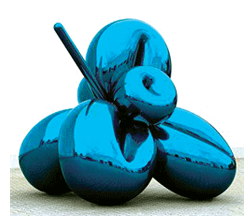 which has contributed to the artist’s global status and taken his market to the highest level at auction. In July 2008 Koons' Balloon Flower (Magenta), 1995-2000, another unique version of this sculpture, broke a world record for the artist at auction, selling at Christie's London for $25,752,051. There are only five Balloon Flowers in existence, each a different color. Koons rendered these works with brilliant reflective surfaces and vibrant colors that suggest a perpetual cycle of happiness and optimism. Other large-scale sculptures in the Celebration series include hanging hearts, diamonds and balloon dogs. Balloon Flower, for Koons, specifically commemorates the springtime when blossoms begin to grow, and the optimism that accompanies that moment of the year. As Koons once stated, “I have always enjoyed flowers. Since taking art lessons as a child, I have had flowers in my work. I always like the sense that a flower just displays itself. The viewer always finds grace in a flower. Flowers are a symbol that life goes for-ward.”
which has contributed to the artist’s global status and taken his market to the highest level at auction. In July 2008 Koons' Balloon Flower (Magenta), 1995-2000, another unique version of this sculpture, broke a world record for the artist at auction, selling at Christie's London for $25,752,051. There are only five Balloon Flowers in existence, each a different color. Koons rendered these works with brilliant reflective surfaces and vibrant colors that suggest a perpetual cycle of happiness and optimism. Other large-scale sculptures in the Celebration series include hanging hearts, diamonds and balloon dogs. Balloon Flower, for Koons, specifically commemorates the springtime when blossoms begin to grow, and the optimism that accompanies that moment of the year. As Koons once stated, “I have always enjoyed flowers. Since taking art lessons as a child, I have had flowers in my work. I always like the sense that a flower just displays itself. The viewer always finds grace in a flower. Flowers are a symbol that life goes for-ward.”
A highlight of the Daimler Art Collection, Balloon Flower (Blue), was acquired directly from the artist. The Daimler Art Collection is part of the automobile company Daimler AG. It comprises almost 2,000 works by over 700 international artists, and has a long established exhibition and global education program. A selection of the collection has been traveling throughout the world and has been on display in major international muse-ums in Germany, Austria, Spain, the United States, South Africa, Japan, Brazil and Argentina, where it has attracted over 500,000 visitors and nearly 50,000 students for its education program. Approximately 30 works of museum quality are acquired each year by the Collection. The proceeds from the sale of Balloon Flower (Blue) will be used to develop the Daimler Art Collection's commitment to art and securing its long term future.